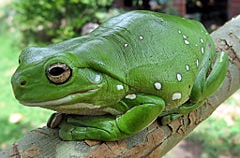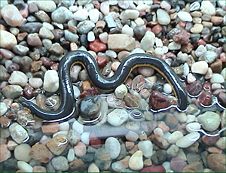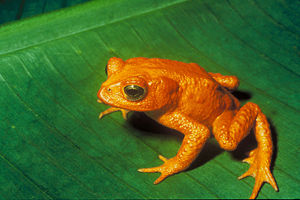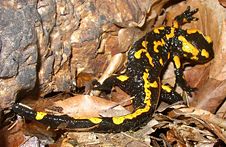Difference between revisions of "Amphibian" - New World Encyclopedia
Rick Swarts (talk | contribs) (Fixed orders in taxobox) |
Rick Swarts (talk | contribs) |
||
| Line 13: | Line 13: | ||
Subclass [[Lepospondyli]] - ''extinct''<br /> | Subclass [[Lepospondyli]] - ''extinct''<br /> | ||
Subclass [[Lissamphibia]]<br /> | Subclass [[Lissamphibia]]<br /> | ||
| − | Order [[Anura]] (or Salientia)<br /> | + | Order [[Anura]] (or (Salientia)<br /> |
Order [[salamander|Caudata]] (or Urodela)<br /> | Order [[salamander|Caudata]] (or Urodela)<br /> | ||
Order [[caecilian|Gymnophiona]] (or Apoda) | Order [[caecilian|Gymnophiona]] (or Apoda) | ||
{{Taxobox_end}} | {{Taxobox_end}} | ||
| − | '''Amphibians''' ( | + | '''Amphibians''' (class '''Amphibia''') are a taxon of [[cold-blooded]] [[animal]]s that include all [[tetrapod]]s (four-legged [[vertebrate]]s) that do not have [[amniotic sac|amniotic]] eggs. An amniotic sac is a tough but thin transparent pair of membranes, which hold a developing embryo (and later fetus) until shortly before birth. |
| + | |||
| + | Amphibians are so diverse in nature that there are few universal, defining characteristics that apply to all species. Amphibians have skin that is smooth and naked, without hair, feathers or true scales. Some possess dermal scales. Unlike fish, amphibians generally respire through the skin and lungs rather than gills, and have limbs instead of fins. (Some amphibians utilize gills as well.) If feet are present, they are webbed and the toes lack claws. Unlike reptiles, amphibians lack a scaly or armored outer covering and respire (oxygen exchange) and absorb water via the skin. The lower skin layer (dermis) of almost all amphibians have mucous glands to provide moisture, as well as poison glands that produce toxins, ranging from mildly noxious to deadly. Generally these are toxic to natural enemies, such as birds and mammals, but harmless to humans. | ||
| + | |||
| + | Most amphibians produce eggs without shells or membranes (amamniotic) that are deposited in water and rely on moisture from the surroundings. Adult amphibians have three chambered hearts (larvae have two-chambered hearts), and usually two lungs. Amphibians have two protusions on the back of the skull (occipital condyles) that articulate with the vertebra of the backbone, whereas reptiles have a single occipital condyle. | ||
| + | |||
| + | Most amphibians are biphasic, having an aquatic stage where they spend part of their time and a terrestrial stage as well. Many change from an aquatic larval stage, where they breathe water and lack limbs, to a terrestrial, air-breathing, four-legged adult form (metamorphosis); however, two-thirds do not incorporate this stratedy (Pough et. al 1998). The term amphibian itself comes from the [[Greek language|Greek]] ''αμφις'' "both" and ''βιος'' "life," meaning double life. In general, amphibians lack the adaptations to an entirely terrestrial existence found in most other modern tetrapods ([[amniote]]s). However, some are fully terrestrial, even being born on land, and other may require only a moist environment. Some are completely aquatic. | ||
| + | |||
| + | Being [[cold-blooded]] organisms, many amphibians enter a state of dormancy under unfavorable conditions, known as hibernation in the winter and estivation in the summer. | ||
| + | |||
| + | Unification aspects?? | ||
| + | |||
| + | There are about 6,000 described, living species of amphibians. Examples include frogs, toads, salamanders, netws, mudpuppies, and caecilians. The study of amphibians and [[reptile]]s is known as [[herpetology]]. | ||
| − | |||
| − | |||
| − | |||
| − | == Classification == | + | == Classification and diversity== |
[[Image:Caecilian.jpg|226px|thumb|right|[[Caecilian]] from the [[San Antonio]] zoo]] | [[Image:Caecilian.jpg|226px|thumb|right|[[Caecilian]] from the [[San Antonio]] zoo]] | ||
Traditionally the amphibians are taken to include all [[tetrapod]]s that are not [[amniote]]s. Recent amphibians all belong to a single subgroup of these, called the [[Lissamphibia]]. Recently there has been a tendency to restrict the class Amphibia to the Lissamphibia, i.e. to exclude tetrapods that are not more closely related to modern forms than they are to modern reptiles, birds, and mammals. | Traditionally the amphibians are taken to include all [[tetrapod]]s that are not [[amniote]]s. Recent amphibians all belong to a single subgroup of these, called the [[Lissamphibia]]. Recently there has been a tendency to restrict the class Amphibia to the Lissamphibia, i.e. to exclude tetrapods that are not more closely related to modern forms than they are to modern reptiles, birds, and mammals. | ||
| Line 40: | Line 49: | ||
Authorities disagree on whether Salientia is a Superorder that includes the order Anura, or whether Anura is a sub-order of the order Salientia. In effect Salientia includes all the Anura plus a single [[Triassic]] proto-frog species, ''[[Triadobatrachus massinoti]]''. Practical considerations seem to favour using the former arrangement now. | Authorities disagree on whether Salientia is a Superorder that includes the order Anura, or whether Anura is a sub-order of the order Salientia. In effect Salientia includes all the Anura plus a single [[Triassic]] proto-frog species, ''[[Triadobatrachus massinoti]]''. Practical considerations seem to favour using the former arrangement now. | ||
| + | |||
| + | |||
| + | |||
| + | == History of amphibians == | ||
| + | [[Image:Salamandra_salamandra_CZ.jpg|thumb|226px|right|[[Fire Salamander]] (''Salamandra salamandra'')]] | ||
| + | Amphibians developed with the characteristics of pharyngeal slits/[[gills]], a [[dorsal nerve cord]], a [[notochord]], and a post-anal tail at different stages of their life. They have persisted since the dawn of tetrapods 390 million years ago in the [[Devonian]] period, when they were the first four-legged animals to develop [[lung]]s. During the following [[Carboniferous]] period they also developed the ability to walk on land to avoid aquatic competition and [[predation]] while allowing them to travel from water source to water source. As a group they maintained the status of the dominant animal for nearly 75 million years. Throughout their history they have ranged in size from the 3 foot (90cm) long Devonian [[Ichthyostega]], to the slightly larger 5 foot (150cm) long [[Permian]] [[Eryops]], and down to the tiny ''[[Brachycephalus didactylus]]'' (Brazilian Gold Frog) and ''[[Eleutherodactylus iberia]]'' from [[Cuba]], with a total length of 9.6-9.8 millimeters (0.4 inches). Amphibians have mastered almost every climate on earth from the hottest deserts to the frozen arctic. | ||
| + | |||
== Reproduction == | == Reproduction == | ||
| Line 51: | Line 67: | ||
* In frogs and toads, the [[tail]] disappears | * In frogs and toads, the [[tail]] disappears | ||
| − | ==Amphibian conservation== | + | ==Amphibian importance and conservation== |
{{main|decline in frog populations}} | {{main|decline in frog populations}} | ||
[[Image:Bufo periglenes1.jpg|thumb|right|300px|The [[Golden toad]] of [[Monteverde]], [[Costa Rica]] was among the first casualties of amphibian declines. Formerly abundant, it was last seen in 1989.]] | [[Image:Bufo periglenes1.jpg|thumb|right|300px|The [[Golden toad]] of [[Monteverde]], [[Costa Rica]] was among the first casualties of amphibian declines. Formerly abundant, it was last seen in 1989.]] | ||
| + | |||
| + | importance of amphibians?? | ||
| + | |||
| + | |||
Dramatic declines in amphibian populations, including population crashes and mass localized [[extinction]], have been noted in the past two decades from locations all over the world, and amphibian declines are thus perceived as one of the most critical threats to global [[biodiversity]]. A number of causes are believed to be involved, including [[habitat destruction]] and modification, over-exploitation, [[pollution]], [[introduced species]], [[climate change]], and disease. However, many of the causes of amphibian declines are still poorly understood, and amphibian declines are currently a topic of much ongoing research. | Dramatic declines in amphibian populations, including population crashes and mass localized [[extinction]], have been noted in the past two decades from locations all over the world, and amphibian declines are thus perceived as one of the most critical threats to global [[biodiversity]]. A number of causes are believed to be involved, including [[habitat destruction]] and modification, over-exploitation, [[pollution]], [[introduced species]], [[climate change]], and disease. However, many of the causes of amphibian declines are still poorly understood, and amphibian declines are currently a topic of much ongoing research. | ||
| Line 91: | Line 111: | ||
| id = {{doi|10.1126/science.1103538}} | | id = {{doi|10.1126/science.1103538}} | ||
}} | }} | ||
| + | |||
| + | Pough, Harvey F., R.M. Andrews, J. E. Cadle, M. L. Crump, A. H. Savitzky & K. D. Wells. 1998: Herpetology. Prentice-Hall, Inc. Upper Saddle River, NJ | ||
| + | |||
| + | |||
== External links == | == External links == | ||
Revision as of 15:51, 27 February 2006
- For other uses, see Amphibian (disambiguation).
| Amphibians | ||||||||
|---|---|---|---|---|---|---|---|---|
 White's Tree Frog (Litoria caerulea) | ||||||||
| Scientific classification | ||||||||
| ||||||||
| Orders | ||||||||
|
Subclass Labyrinthodontia - extinct |
Amphibians (class Amphibia) are a taxon of cold-blooded animals that include all tetrapods (four-legged vertebrates) that do not have amniotic eggs. An amniotic sac is a tough but thin transparent pair of membranes, which hold a developing embryo (and later fetus) until shortly before birth.
Amphibians are so diverse in nature that there are few universal, defining characteristics that apply to all species. Amphibians have skin that is smooth and naked, without hair, feathers or true scales. Some possess dermal scales. Unlike fish, amphibians generally respire through the skin and lungs rather than gills, and have limbs instead of fins. (Some amphibians utilize gills as well.) If feet are present, they are webbed and the toes lack claws. Unlike reptiles, amphibians lack a scaly or armored outer covering and respire (oxygen exchange) and absorb water via the skin. The lower skin layer (dermis) of almost all amphibians have mucous glands to provide moisture, as well as poison glands that produce toxins, ranging from mildly noxious to deadly. Generally these are toxic to natural enemies, such as birds and mammals, but harmless to humans.
Most amphibians produce eggs without shells or membranes (amamniotic) that are deposited in water and rely on moisture from the surroundings. Adult amphibians have three chambered hearts (larvae have two-chambered hearts), and usually two lungs. Amphibians have two protusions on the back of the skull (occipital condyles) that articulate with the vertebra of the backbone, whereas reptiles have a single occipital condyle.
Most amphibians are biphasic, having an aquatic stage where they spend part of their time and a terrestrial stage as well. Many change from an aquatic larval stage, where they breathe water and lack limbs, to a terrestrial, air-breathing, four-legged adult form (metamorphosis); however, two-thirds do not incorporate this stratedy (Pough et. al 1998). The term amphibian itself comes from the Greek αμφις "both" and βιος "life," meaning double life. In general, amphibians lack the adaptations to an entirely terrestrial existence found in most other modern tetrapods (amniotes). However, some are fully terrestrial, even being born on land, and other may require only a moist environment. Some are completely aquatic.
Being cold-blooded organisms, many amphibians enter a state of dormancy under unfavorable conditions, known as hibernation in the winter and estivation in the summer.
Unification aspects??
There are about 6,000 described, living species of amphibians. Examples include frogs, toads, salamanders, netws, mudpuppies, and caecilians. The study of amphibians and reptiles is known as herpetology.
Classification and diversity

Traditionally the amphibians are taken to include all tetrapods that are not amniotes. Recent amphibians all belong to a single subgroup of these, called the Lissamphibia. Recently there has been a tendency to restrict the class Amphibia to the Lissamphibia, i.e. to exclude tetrapods that are not more closely related to modern forms than they are to modern reptiles, birds, and mammals.
There are two ancient, extinct, subclasses:
- Subclass Labyrinthodontia (paraphyletic)
- Subclass Lepospondyli
Of the remaining modern subclass Lissamphibia there are three orders:
- Order Anura (frogs and toads) (in Superorder Salientia): 5,228 species
- Order Caudata or Urodela (salamanders): 552 species
- Order Gymnophiona or Apoda (caecilians): 171 species
Authorities disagree on whether Salientia is a Superorder that includes the order Anura, or whether Anura is a sub-order of the order Salientia. In effect Salientia includes all the Anura plus a single Triassic proto-frog species, Triadobatrachus massinoti. Practical considerations seem to favour using the former arrangement now.
History of amphibians
Amphibians developed with the characteristics of pharyngeal slits/gills, a dorsal nerve cord, a notochord, and a post-anal tail at different stages of their life. They have persisted since the dawn of tetrapods 390 million years ago in the Devonian period, when they were the first four-legged animals to develop lungs. During the following Carboniferous period they also developed the ability to walk on land to avoid aquatic competition and predation while allowing them to travel from water source to water source. As a group they maintained the status of the dominant animal for nearly 75 million years. Throughout their history they have ranged in size from the 3 foot (90cm) long Devonian Ichthyostega, to the slightly larger 5 foot (150cm) long Permian Eryops, and down to the tiny Brachycephalus didactylus (Brazilian Gold Frog) and Eleutherodactylus iberia from Cuba, with a total length of 9.6-9.8 millimeters (0.4 inches). Amphibians have mastered almost every climate on earth from the hottest deserts to the frozen arctic.
Reproduction
For the purpose of reproduction most amphibians are bound to fresh water. A few tolerate brackish water, but there are no true sea water amphibians. Several hundred frog species in adaptive radiations (e.g., Eleutherodactylus, the Pacific Platymantines, the Australo-Papuan microhylids, and many other tropical frogs), however, do not need any water whatsoever. They reproduce via direct development, an ecological and evolutionary adaptation that has allowed them to be completely independent from free-standing water. Almost all of these frogs live in wet tropical rainforests and their eggs hatch directly into miniature versions of the adult, bypassing the tadpole stage entirely. Several species have also adapted to arid and semi-arid environments, but most of them still need water to lay their eggs. Symbiosis with single celled algae that lives in the jelly-like layer of the eggs has evolved several times. The larvae (tadpoles or polliwogs) breathe with exterior gills. After hatching, they start to transform gradually into the adult's appearance. This process is called metamorphosis. Typically, the animals then leave the water and become terrestrial adults, but there are many interesting exceptions to this general way of reproduction.
The most obvious part of the amphibian metamorphosis is the formation of four legs in order to support the body on land. But there are several other changes:
- The gills are replaced by other respiratory organs, i.e. lungs.
- The skin changes and develops glands to avoid dehydration
- The eyes get eyelids and adapt to vision outside the water
- An eardrum is developed to lock the middle ear
- In frogs and toads, the tail disappears
Amphibian importance and conservation

importance of amphibians??
Dramatic declines in amphibian populations, including population crashes and mass localized extinction, have been noted in the past two decades from locations all over the world, and amphibian declines are thus perceived as one of the most critical threats to global biodiversity. A number of causes are believed to be involved, including habitat destruction and modification, over-exploitation, pollution, introduced species, climate change, and disease. However, many of the causes of amphibian declines are still poorly understood, and amphibian declines are currently a topic of much ongoing research.
See also
- Frog zoology
- Prehistoric amphibian
- Tetrapod
ReferencesISBN links support NWE through referral fees
- Duellman/Trueb, Biology of Amphibians
- Pounds, J. Alan and Martín R. Bustamante, Luis A. Coloma, Jamie A. Consuegra, Michael P. L. Fogden, Pru N. Foster, Enrique La Marca, Karen L. Masters, Andrés Merino-Viteri, Robert Puschendorf, Santiago R. Ron, G. Arturo Sánchez-Azofeifa, Christopher J. Still and Bruce E. Young (January 2006). Widespread amphibian extinctions from epidemic disease driven by global warming. Nature 439: 161-167. Digital object identifier (DOI): 10.1038/nature04246.
- Solomon Berg Martin, Biology
- Stuart, Simon N. and Janice S. Chanson, Neil A. Cox, Bruce E. Young, Ana S. L. Rodrigues, Debra L. Fischman, Robert W. Waller (December 2004). Status and trends of amphibian declines and extinctions worldwide. Science 306 (5702): 1783-1786. Digital object identifier (DOI): 10.1126/science.1103538.
Pough, Harvey F., R.M. Andrews, J. E. Cadle, M. L. Crump, A. H. Savitzky & K. D. Wells. 1998: Herpetology. Prentice-Hall, Inc. Upper Saddle River, NJ
External links
- American Museum of Natural History: Department of herpetology
- The Global Amphibian Assessment
- AmphibiaWeb
Credits
New World Encyclopedia writers and editors rewrote and completed the Wikipedia article in accordance with New World Encyclopedia standards. This article abides by terms of the Creative Commons CC-by-sa 3.0 License (CC-by-sa), which may be used and disseminated with proper attribution. Credit is due under the terms of this license that can reference both the New World Encyclopedia contributors and the selfless volunteer contributors of the Wikimedia Foundation. To cite this article click here for a list of acceptable citing formats.The history of earlier contributions by wikipedians is accessible to researchers here:
The history of this article since it was imported to New World Encyclopedia:
Note: Some restrictions may apply to use of individual images which are separately licensed.


